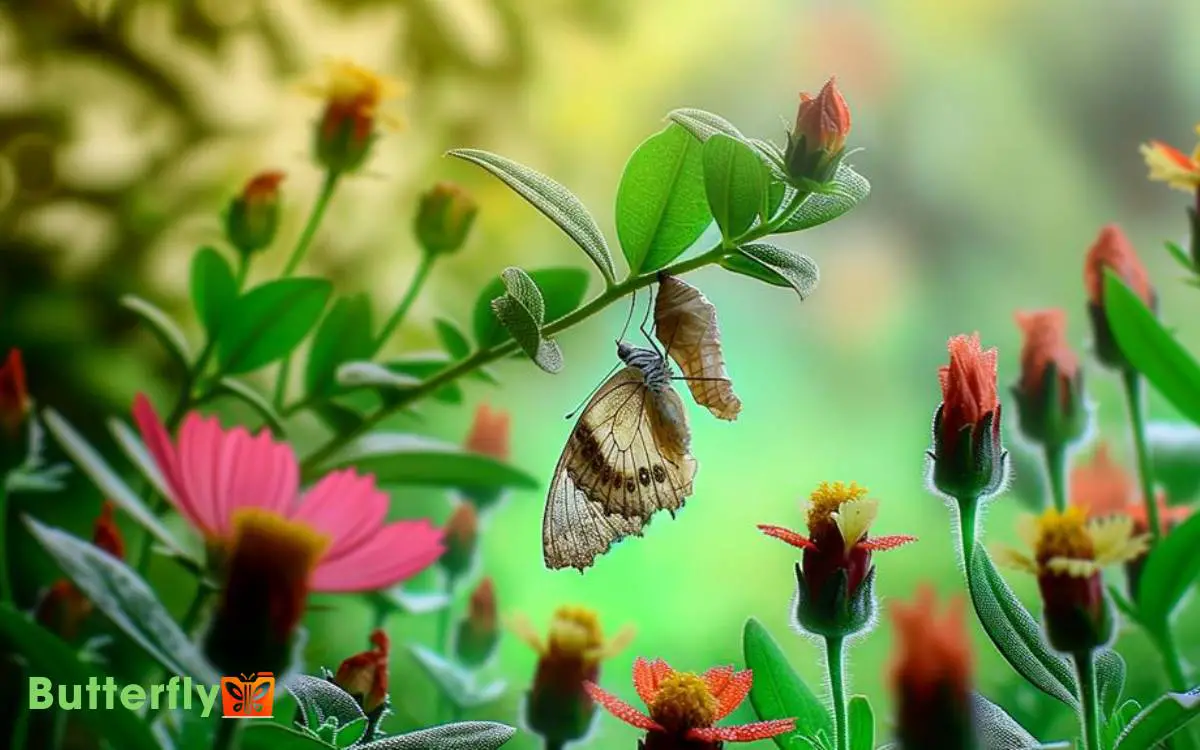Can You Help a Butterfly Out of Its Chrysalis? Explore!
Helping a butterfly out of its chrysalis can be essential. The emergence process is meticulously regulated by hormones like ecdysone, ensuring each developmental step occurs properly. The struggle to break free strengthens the wings, which is vital for flight.
Interfering can deform the butterfly’s wings, prevent fluid redistribution, and hinder muscle development. This natural transformation involves breaking down caterpillar tissues into a nutrient-rich soup and forming adult structures via imaginal cells.
Intervening disrupts these molecular events and reduces the butterfly’s chances of survival. Learn how observing this process without interference can support their successful transformation.

Key Takeaways
Understanding Metamorphosis
Metamorphosis, the biological process by which a caterpillar transforms into a butterfly, involves a series of intricate and well-coordinated stages that are essential for the insect’s development and survival.
You’ll find that this transformation isn’t just a simple change but a complex reorganization of the caterpillar’s entire structure.
Inside the chrysalis, cells called imaginal discs, which were dormant in the larval stage, rapidly multiply and differentiate to form the butterfly’s wings, antennae, and other adult features. Hormones like ecdysone play a pivotal role in regulating these changes.
Understanding these processes helps you appreciate the delicate balance required for successful metamorphosis and underscores why external interference can be detrimental to the emerging butterfly‘s health and survival.
Stages of Development
The stages of development in a butterfly’s life cycle are divided into four distinct phases: egg, larva, pupa, and adult.
- You start with the egg, where embryonic development occurs.
- The larva, or caterpillar, emerges next, focusing on eating and growing, molting several times as it outgrows its skin.
- The pupa stage, also called the chrysalis, is where the most dramatic transformation happens, though it’s externally still.
- Finally, the adult butterfly emerges, ready to reproduce and continue the cycle.
- Each stage is vital and highly specialized, ensuring the butterfly’s successful shift from one phase to the next.
Understanding these stages helps you appreciate the intricacies of metamorphosis and the importance of each developmental phase.
Inside the Chrysalis
Peering inside the chrysalis, you’ll witness a remarkable biochemical transformation as the caterpillar’s body breaks down into a nutrient-rich soup, paving the way for the formation of adult structures.
Enzymes dissolve the caterpillar’s tissues, reducing them to a primordial mix called imaginal cells. These specialized cells then differentiate and reorganize to form the butterfly’s wings, antennae, and legs.
The process relies heavily on genetic instructions encoded within the DNA, ensuring precise development. Hormonal signals, particularly ecdysone, coordinate these changes, regulating the timing and progression of metamorphosis.
This intricate dance of molecular events underscores nature’s complexity, turning a crawling larva into a winged adult. Each stage is meticulously orchestrated, demanding both time and biological resources for successful completion.
The Emergence Process
As you observe the emergence process, you’ll notice the butterfly’s natural transformation is intricate and highly regulated.
The struggle to break free from the chrysalis is vital, as it helps strengthen the butterfly’s wings.
Any interference in this process can adversely affect its development and ability to fly.
Natural Transformation Process
Witnessing a butterfly’s emergence from its chrysalis offers a fascinating glimpse into the intricate and highly regulated process of metamorphosis.
During this stage, the butterfly undergoes significant physiological changes. Enzymes break down the caterpillar’s tissues, recycling them to form the adult structures of the butterfly.
The chrysalis serves as a protective casing, allowing these transformations to occur in a controlled environment.
You’ll notice the butterfly using rhythmic movements to free itself. These movements aren’t random; they’re critical for the insect to correctly unfold its wings and prepare for flight.
The final stage involves pumping hemolymph into the wings to expand them, followed by a period of hardening before the butterfly is ready to take flight.
Role of Struggle
Understanding the critical role of struggle during the butterfly’s emergence from its chrysalis reveals how this seemingly arduous process is crucial for the insect’s survival and fitness.
When a butterfly pushes through its chrysalis, it strengthens its wings and body. Blood is forced into the wing veins, expanding and hardening them, preparing the butterfly for flight. Without this physical exertion, the wings remain underdeveloped and flightless.
The struggle also helps expel waste products accumulated during metamorphosis. By undergoing this strenuous process, the butterfly guarantees its body functions at its best.
This natural challenge isn’t merely an obstacle but an essential sequence that primes the butterfly for the demands of life outside the chrysalis.
Impacts on Development
The emergence process profoundly impacts a butterfly’s development by guaranteeing its physiological systems are fully prepared for survival in the external environment.
When a butterfly struggles to free itself from the chrysalis, it stimulates crucial processes like wing expansion and blood circulation. Without this effort, the butterfly’s wings may remain crumpled and its body weak, reducing its chances for successful flight and evading predators.
Here’s a brief look at the emergence process:
| Stage | Physiological Impact | Survival Benefit |
|---|---|---|
| Initial Break | Strengthens muscles | Prepares for flight |
| Wing Expansion | Blood circulation | Ensures wings are functional |
| Final Escape | Full body activation | Readies all systems for immediate action |
| Rest Period | Wing drying | Enhances flight capability |
| First Flight | Muscle coordination | Increases chances of finding food and mates |
Understanding these impacts underscores the importance of allowing the natural emergence process to unfold.
Struggles and Challenges
When observing a butterfly’s natural emergence process, you might notice the significant physical effort required as it exits its chrysalis.
Interrupting this process can cause potential harm, such as malformed wings or insufficient muscle development.
As a result, it’s important to maintain patience and allow the butterfly to complete this essential stage independently.
Natural Emergence Process
Emerging from the chrysalis, a butterfly faces significant physiological and environmental challenges that are essential for its survival and development.
The process requires the insect to break free from its hardened casing, which demands substantial physical effort. This struggle is critical as it forces fluid from the butterfly’s body into its wings, allowing them to expand and harden properly.
Additionally, the butterfly must contend with environmental factors such as temperature and humidity, which can affect the success of its emergence.
The entire process tests the butterfly’s resilience and readiness for life outside the chrysalis. Without these challenges, the butterfly’s wings wouldn’t develop correctly, impairing its ability to fly and ultimately survive in its natural habitat.
Potential Harm Risks
Facing potential harm, a butterfly’s struggle out of its chrysalis is fraught with risks that can impede its development and survival. You might think helping is beneficial, but intervening can damage the delicate wings or disrupt essential physiological processes.
The butterfly’s emergence requires precise mechanical movements and enzymatic reactions to break free.
Without the natural struggle, the wings may not fully expand or harden, leaving the butterfly unable to fly. Additionally, premature assistance can cause fluid imbalances, affecting the insect’s overall health.
Each phase of eclosion, the act of emerging, is critical for ensuring the butterfly’s structural integrity and functional capabilities. Understanding these risks highlights why careful observation, rather than direct intervention, is necessary for the butterfly’s successful adaptation.
Importance of Patience
In observing a butterfly’s emergence from its chrysalis, patience is vital to allow the insect to undergo its natural and necessary struggles, which are essential for its development and survival. Without this phase, the butterfly might not develop the muscle strength needed for flight.
The struggles help in redistributing fluids to its wings, making them strong and capable. You must resist the urge to assist, as premature interference can lead to malformed wings or an inability to fly.
Here’s a quick overview of why patience is critical:
| Aspect of Struggle | Importance |
|---|---|
| Wing strength development | Ensures the butterfly can fly effectively |
| Fluid redistribution | Proper wing expansion |
| Muscle development | Critical for mobility |
| Natural process adherence | Mimics evolutionary success |
| Avoiding deformities | Prevents improper wing formation |
The Importance of Struggle
A butterfly’s struggle to escape its chrysalis is a critical process that strengthens its wings, ensuring it can fly once it emerges.
During this struggle, hemolymph an insect’s blood gets pumped into the wing veins, expanding and hardening them. This effort not only fortifies the wings but also enables the butterfly to control its movements effectively.
Without this natural resistance, the wings remain underdeveloped and incapable of supporting flight. The act of breaking free also stimulates the butterfly’s metabolism, preparing it for the energetic demands of adult life.
By engaging fully in this struggle, the butterfly achieves the physical readiness necessary for survival in its environment.
Understanding this underscores the importance of allowing natural processes to unfold without intervention.
Risks of Interference
Intervening in a butterfly’s emergence from its chrysalis can lead to developmental consequences, disrupting the natural process vital for its maturation.
By assisting, you’re likely to impair the butterfly’s ability to strengthen its wings, which reduces its chances of survival in the wild.
Understanding these risks is essential to guarantee the butterfly’s successful progression to adulthood.
Developmental Consequences
Tampering with a butterfly’s emergence from its chrysalis can severely disrupt its natural development, potentially leading to physical deformities and weakened structures.
When you interfere, you risk damaging the delicate wings, which may result in improper expansion and drying.
The butterfly’s muscles and exoskeleton also require the struggle to build the necessary strength for survival. Without this essential process, the butterfly may be too weak to fly or fend for itself.
Additionally, the act of emergence helps circulate hemolymph (insect blood) to vital areas, ensuring proper physiological function. By intervening, you hinder these critical developmental stages, compromising the butterfly’s ability to thrive.
Understanding these consequences highlights the importance of allowing nature to take its course.
Natural Process Disruption
Disrupting the natural process of a butterfly’s emergence from its chrysalis can lead to a cascade of detrimental effects on its physiological and structural integrity.
By intervening, you risk causing significant harm, including:
- Incomplete Wing Expansion: The butterfly’s wings may not fully expand, leading to deformities.
- Hemolymph Circulation Issues: Proper circulation of hemolymph (insect blood) is vital; any disruption can impair this process.
- Muscle Development Problems: Emerging naturally is essential for strengthening muscles needed for flight.
- Increased Vulnerability to Predators: Weak or deformed butterflies are more susceptible to predation.
These risks highlight the importance of allowing the butterfly to complete its emergence independently. Interference can severely compromise its ability to survive and thrive in its natural environment.
Survival Chances Reduced
When you assist a butterfly in emerging from its chrysalis, you greatly reduce its chances of survival by hindering essential developmental processes. The struggle to exit the chrysalis is vital for strengthening the butterfly’s wings and ensuring proper fluid distribution.
Without this process, the wings may remain undeveloped and flightless, making the butterfly vulnerable to predators and unable to feed. In such cases, learning how to fix a butterfly wing can be crucial for its survival, as damaged wings can hinder movement and daily functions. Providing proper care and support can help the butterfly regain mobility and improve its chances of thriving in the wild.
| Developmental Process | Natural Outcome | Interfered Outcome |
|---|---|---|
| Wing Strengthening | Robust Wings | Weak Wings |
| Fluid Distribution | Balanced Fluids | Imbalanced Fluids |
| Muscle Development | Strong Muscles | Weakened Muscles |
| Behavioral Adaptation | Survival Skills | Survival Risks |
Understanding these risks emphasizes the importance of allowing natural metamorphosis to occur without human interference. Your well-intentioned help can inadvertently seal the butterfly’s fate.
Long-Term Effects
Helping a butterfly out of its chrysalis can lead to long-term developmental issues, as the insect’s wings may not fully expand or harden properly.
This impairment can have several detrimental effects:
- Flight Inefficiency: The butterfly may struggle to fly, affecting its ability to search for food and evade predators.
- Reproductive Challenges: Limited mobility can reduce its chances of finding mates, thereby impacting reproduction.
- Reduced Lifespan: Physical deformities and stress from incomplete development can shorten the butterfly’s life.
- Vulnerability to Predation: Weakened wings make the butterfly an easier target for predators.
Understanding these long-term effects underscores the importance of allowing butterflies to emerge naturally, ensuring they develop fully and function effectively in their environment.
Natural Timing
Allowing butterflies to emerge from their chrysalises at their own pace guarantees that their physiological processes, such as wing expansion and hardening, occur at their best possible state. During this time, the butterfly undergoes significant biochemical changes.
Hemolymph, the insect equivalent of blood, pumps into the wings, causing them to unfurl and strengthen.
If you interfere and speed up this process, it can result in improperly formed wings that hinder flight. Timing is critical because it ensures the complete development of flight muscles and the exoskeleton.
Observing Safely
Ensuring you observe butterflies emerging from their chrysalises safely involves maintaining a respectful distance and creating a disturbance-free environment to prevent stress on the developing insect.
It’s vital to take into account these guidelines to guarantee the butterfly’s successful emergence:
- Maintain a Distance: Stand at least a few feet away to avoid casting shadows or causing vibrations.
- Limit Noise: Keep the area quiet to avoid startling the butterfly.
- Avoid Touching: Refrain from touching the chrysalis as it can disrupt the delicate process.
- Use Gentle Lighting: Natural light is ideal; if using artificial light, make sure it’s soft and indirect.
Following these steps helps you witness this remarkable transformation without interfering with the butterfly’s critical development stages.
Creating a Butterfly Garden
Designing a butterfly garden involves selecting native plants that provide nectar and serve as host plants for caterpillars, ensuring an essential habitat for these delicate pollinators.
You should choose a variety of flowering plants that bloom at different times, providing continuous nectar sources. Species like milkweed, coneflowers, and asters are excellent choices.
Additionally, include host plants such as dill, fennel, and parsley to support caterpillar growth. Consider the garden’s layout to offer both sunlit areas and sheltered spots, as butterflies need warmth but also protection from wind.
Maintaining a chemical-free environment is vital; pesticides can harm both butterflies and their larvae.
Supporting Local Wildlife
Creating a haven for local wildlife involves carefully selecting native plants, providing water sources, and ensuring safe shelter areas to support a diverse range of species.
You can have a substantial impact on your local ecosystem by following these steps:
- Plant Native Species: Choose plants that are indigenous to your region. They require less water and provide essential food and habitat for local wildlife.
- Provide Water Sources: Install birdbaths, small ponds, or shallow dishes. Clean and refill them regularly to attract birds, insects, and small mammals.
- Create Shelter Areas: Use logs, rocks, and brush piles to offer protection from predators and harsh weather.
- Avoid Pesticides: Use natural pest control methods to maintain a healthy, chemical-free environment that supports beneficial insects and wildlife.
Educating Others
Teaching others about the importance of supporting local wildlife can greatly amplify your conservation efforts and foster a community-wide commitment to protecting natural habitats.
Start by explaining the role butterflies play in pollination and ecosystem balance. Use scientific data to illustrate how their presence indicates a healthy environment.
Show the life cycle of a butterfly, emphasizing the critical stages like the chrysalis phase. Highlight the dangers of premature interference and why patience is essential.
Encourage hands-on activities, such as creating butterfly gardens or participating in citizen science projects.
Conclusion
You’ve explored the intricate dance of metamorphosis, the epic transformation from caterpillar to butterfly.
Resisting the urge to assist a struggling butterfly is essential; their battle to break free strengthens their wings, important for survival.
By observing respectfully, creating a butterfly haven, and spreading knowledge, you’re not just aiding a single butterfly but contributing to the grand tapestry of local wildlife.
So, step back, let nature’s wonders unfold, and marvel at the spectacular beauty of life’s relentless persistence.






